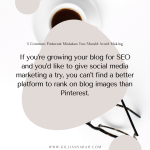
5 Common Pinterest Mistakes You Should Avoid Making
Table of Contents
ToggleSharing is caring!
Reading Time: 3 minutes


If you’re growing your blog for SEO, and you’d like to give social media marketing a try, you can't find a better platform to rank on blog images than Pinterest. Like anything in life, there are best practices to consider and some mistakes that must be avoided at all costs. To make sure that you are getting the results you expect from your SEO/online marketing efforts, avoid these common Pinterest mistakes:
Getting the Image Sizes Wrong
Pinterest is a very visual-driven platform, making sense to use images in impeccable quality. One way to make sure that the images look crisp and clean on any screen is by choosing the pins' right image size.
According to experts, Pinterest favours the 2:3, 600 x 900 px ratio. The popularity of Instagram made square images widespread on Pinterest, so that's a great size to use as well.
Back in the day when infographics were very new, Pinterest would feature longer pins, but that's not the case these days. Try to avoid using longer pins because the platform is now demoting this image dimension.
Forgoing Optimization in the Descriptions
These days, Pinterest works as a search engine for images. And if you’ve been forgoing the optimization in your image descriptions, you could be losing a lot of viewers every day. Optimizing your images with your main keywords and/or keyword phrases is always an important step.
Don’t miss the opportunity to top the Pinterest searches with your images simply because you thought SEO only applies to text images or search engines, in general. Like Pinterest, Instagram, Facebook, and even Twitter, social media platforms are using keywords for search rankings.
Stagnant Pinning Strategy
If you’ve been pinning your images on auto-pilot without thinking much about the quality of the images you are putting out there, you might not get better results with your pinning strategy.
Before you start pinning, check the image ratio. It should be 2:3 size ratio. Your descriptions should be easy to read – direct and concise. Ensure that the photos you are using connect with your branding through the colour scheme, typography, and content.
Please do not use a random picture that strays from your branding; otherwise, it will create inconsistencies that lead to confusion among your existing followers. Your pins should always be well designed, well-planned, and organized.
Ugly Pin Designs
Because Pinterest is a visual-centric platform, viewers expect to see visually-appealing images. If your pins are not well-put-together, they won't get a lot of attention from viewers. And yes, there are ugly pins out there, and you don't want your brand to be associated with the word “ugly” at all. You don't have to be a designing expert to create beautiful pins. You need to be very careful with the kind of pins you use for your Pinterest account.
Not Switching to a Business Account
Are you still using a personal account to promote your business? Not only are you confusing your target audience with this practice, but you're also violating Pinterest's Terms of Service.
Personal Pinterest accounts have their limitations because these accounts are only good for personal use. You're not reaching as many people, and the features might be limited. Switching to a business account allows you to reach more people and create a market strategy that suits your business. With a business account, you can also keep your personal pins separate from your business account.
It doesn’t take much to be Pinterest-famous, keep these important tips in mind. And remember, providing real value is the best way to attract more people into your website and blog site. As long as your pins are Pinterest-worthy, they will serve you well on this social media platform!
Most Popular Posts:
Sharing is caring!
Great insights! Nailing the right image size is key – that 2:3 ratio is like the secret sauce for visual appeal on Pinterest.